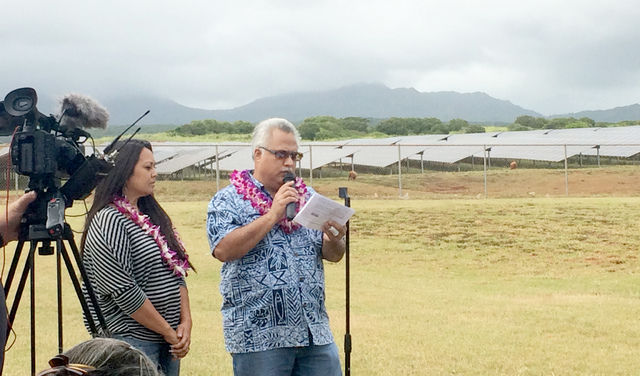ANAHOLA — Anahola is now home of the largest solar array in the state. And the solar panels contributing to that designation — all 59,000 of them — were celebrated Saturday at a dedication ceremony attended by about 60 people.
ANAHOLA — Anahola is now home of the largest solar array in the state.
And the solar panels contributing to that designation — all 59,000 of them — were celebrated Saturday at a dedication ceremony attended by about 60 people.
“We are leading the state in so many different ways,” said Mayor Bernard Carvalho Jr. “In energy efficiency, in food sustainability, clean energy, smart growth. I just want to tell you folks how important this is for Kauai and for Anahola, of course, as we really utilize our natural resources and bring it back to the people.”
The 12 megawatt, $54 million solar farm is owned by Kauai Island Utility Cooperative, which is chasing a goal of generating half of the island’s power from renewable sources by 2023.
The project went online in October.
The Anahola solar array is expected to produce 23,525 megawatt-hours of electricity per year — about 5.5 percent of the total power generated — and save cooperative customers an estimated $250,000 per month in costs. It will also reduce localized power outages and service disruptions, according to an environmental assessment of the project.
The project is the product of an innovative partnership between KIUC and Native Hawaiian homesteaders in Anahola, who gave the green light for the 60-acre facility to be built on a 422-acre parcel of land owned by the Department of Hawaiian Home Lands.
DHHL approved a 25-year land lease for the solar farm, which will help fund Hawaiian advancement initiatives including the development of more housing for homesteaders, who in some cases have been waiting decades to obtain a homestead land lease.
A solar advisory committee organized by the Anahola Hawaiian Homestead Association has been regularly contributing to planning discussions, culminating with Saturday’s dedication ceremony.
“For us, the most important thing about this project looking forward is that we’re looking at two decades of partnership with KIUC where we can bring benefits to the youth and to the families and to the people of Anahola,” said Anahola Hawaiian Homes Association President Kipukai Kuali’i, who is also a county councilmember. “I think sometimes it’s hard for government to let go of even a little bit of control. But there’s no better way to engage community and involve community and to maximize community volunteering than for government to include them and let go of some of the control.”
Saturday’s event featured food and a series of site tours. Also on hand were dozens of sheep. The animals, on loan from local ranchers, could be seen grazing between the solar panels, chowing down on fresh grass that would be difficult to mow. The sheep are a mainstay of the project, eliminating the need to spray herbicides.
State Rep. Derek Kawakami thanked the Anahola community for taking on a project that will benefit the whole island.
“In the day and age of having NIMBY, Not In My Backyard, to have the community of Anahola, which is doing such great things, to be able to step up to the plate and say, ‘Bring it here. Build it in our back yard. We’re willing to take the project to improve the rest of the island,’ for that, I would like to give them a big, ‘Aloha,’” Kawakami said.


